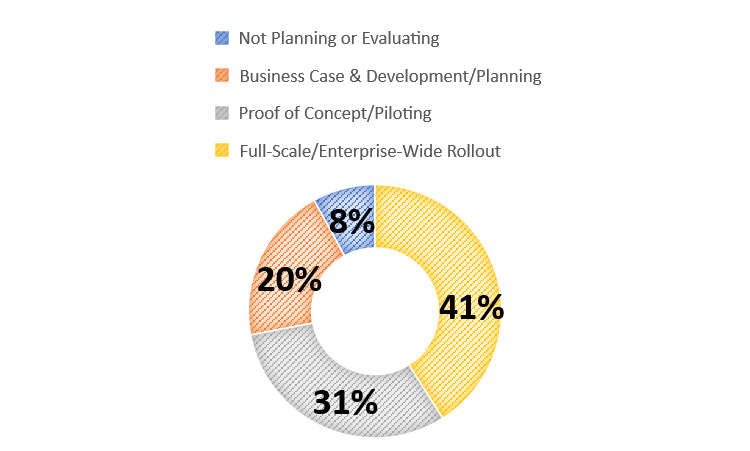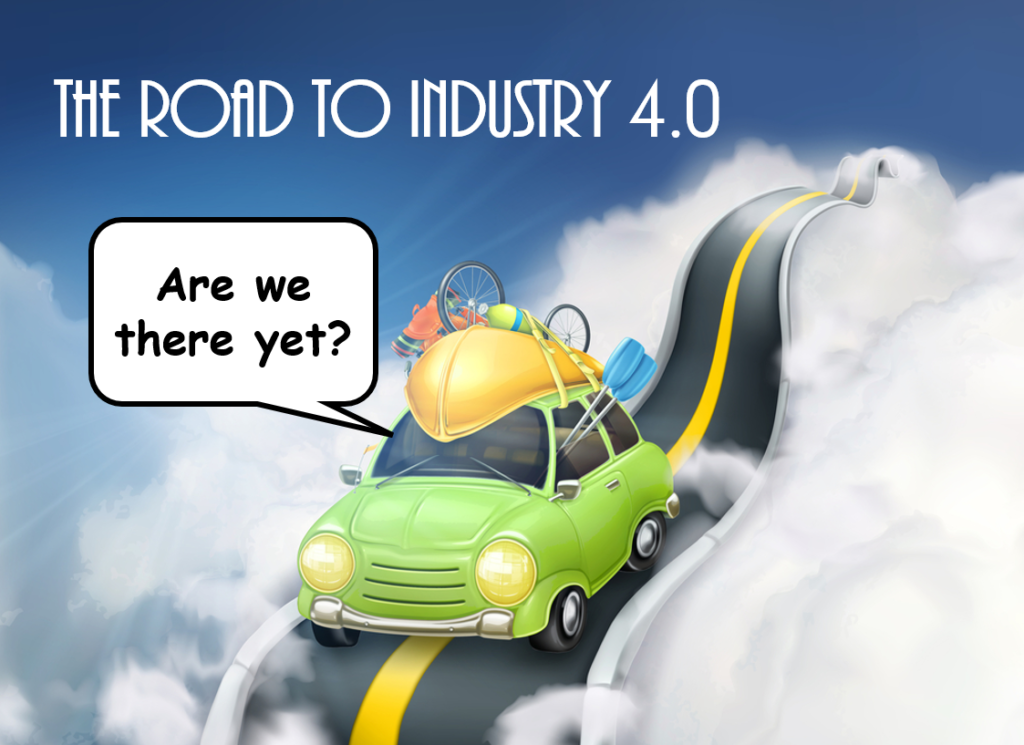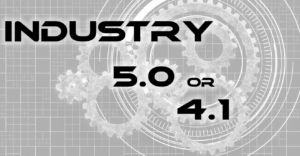Family car trips are often characterized as torturous journeys during which children constantly pester their parents by repeatedly asking, “Are we there yet?” The same question is often asked about the Fourth Industrial Revolution (aka Industry 4.0). Arno Koch, a partner at OEE Coach BV and owner of Makigami BV, has a couple of other questions. He asks, “Does everyone have the same idea about the definition of Industry 4.0 and how far are we now really in this process? And what is 4.0 really about?”[1] In order to determine how far along we are on the road to Industry 4.0 and whether we’re there yet, we need to understand where we are going. According to the World Economic Forum (WEF):
“The Fourth Industrial Revolution represents a fundamental change in the way we live, work, and relate to one another. It is a new chapter in human development, enabled by extraordinary technology advances commensurate with those of the first, second, and third industrial revolutions. These advances are merging the physical, digital and biological worlds in ways that create both huge promise and potential peril. The speed, breadth and depth of this revolution is forcing us to rethink how countries develop, how organizations create value and even what it means to be human. The Fourth Industrial Revolution is about more than just technology-driven change; it is an opportunity to help everyone, including leaders, policymakers and people from all income groups and nations, to harness converging technologies in order to create an inclusive, human-centered future. The real opportunity is to look beyond technology, and ways to give the greatest number of people the ability to positively impact their families, organizations and communities.”[2]
The term Industry 4.0 was coined in Germany a decade ago, to help the country strategize about the future. However, based on the World Economic Forum’s sweeping definition of Industry 4.0, I think it’s fair to say we’re not there yet.
Industry 4.0 Technology
A survey conducted by PTC confirmed that the Industry 4.0 journey has been completed by fewer than half of the polled organizations; however, the road to Industry 4.0 is getting crowded by companies that have begun the trip. The survey found, “92% of industrial companies are on a DX journey.”[3] The survey also found less than half (41%) have achieved a full-scale, enterprise-wide rollout of digital technologies. The following graphic depicts where PTC found companies on the road to Industry 4.0.

For many companies, the pandemic highlighted the importance of digital technologies and helped identify where technological gaps exist. As PTC analysts explain, “Where you are in your DX journey determines priorities and challenges.” Even though the WEF insists “the Fourth Industrial Revolution is more than just technology-driven change,” technology is obviously the sine qua non of Industry 4.0. Despite an economy tossed into disarray by the pandemic, investments in technology continued to increase. Journalist Rob Spiegel reports, “One constant through the turbulence of the pandemic was the increasing use of digital technologies. IDC estimates that global spending on digital transformation (DX) technologies and services hit an impressive $1.3 trillion in 2020.”[4] PTC analysts insist manufacturers should be careful to select the best-in-class technology as they pursue digital transformation. After all, they note, “Technology is at the core of DX.”
The Road to Industry 4.0
Craig Melrose, Executive Vice President of digital transformation solutions at PTC, told Spiegel, “[Companies shouldn’t] let a good crisis go to waste. We need to adjust our existing plans to grow upon. And because of all the change, there is less resistance than ever to change management.” Melrose identified seven essential steps companies should take to drive digital transformation success. They are:
Step 1. Align on the Why. We are all familiar with adages like, “Change for the sake of change, benefits no one” and “Change, for the sake of change, is a recipe for failure.” On the other hand, three business professors, Freek Vermeulen (@Freek_Vermeulen), from the London Business School, Phanish Puranam, from INSEAD, and Ranjay Gulati, from Harvard Business School, insist, “No one disputes that firms have to make organizational changes when the business environment demands them. But the idea that a firm might want change for its own sake often provokes skepticism. Why inflict all that pain if you don’t have to? That is a dangerous attitude. A company periodically needs to shake itself up, regardless of the competitive landscape.”[5] Regardless of whether you are digitally transforming your company because the environment demands it or because it’s time for a shake-up, explaining why you are doing it and getting everyone on board is essential to success. As PTC analysts explain, “[You need to] define the business value of digital transformation.”
Step 2. Prepare for Culture Change. The WEF definition expressly notes, the Fourth Industrial Revolution “represents a fundamental change in the way we live, work, and relate to one another.” Tricia Wang (@triciawang), a self-described Tech Ethnographer & Sociologist, agrees. She explains, “A lot of companies treat digital as if they are ‘doing digital’ — this is ‘digitization’ at its worst — as if it’s some checklist of things to do. It’s very transactional, and people are so busy doing digital they don’t even know WHY they are doing it in the first place! Whereas [some companies] embrace ‘being digital’ — this is ‘digital transformation’ at its best — it’s a total paradigm shift in the culture and operations — it’s not just about buying the latest digital tool, but about creating a new system, new cadence, new mindset.”[6] In order to prepare for culture change, PTC analysts insist, “[A company must] put humans at the heart of digital transformation.”
Step 3. Start Small but Strategic. There is a reason for the old adage, “Don’t bite off more than you can chew.” At Enterra Solutions®, we suggest to our clients that they take a “crawl, walk, run” approach to digital transformation. PTC analysts suggest one reason to start small is to improve your chances of success. They note, “[Companies should] jump-start digital transformation with an impactful, measurable initiative.”
Step 4. Map out Technology. Even though PTC analysts insist technology is at the core of DX, there is a reason it isn’t mentioned until step 4. Knowing what you want, identifying the strategy that will get you there, and getting buy-in from your people must all come before technology comes into play. Once those pieces are in place, PTC analysts assert, “[Companies should] choose tech solutions that scale with their long-term strategy.”
Step 5. Seek Out Partners & Expertise. If the Digital Age has taught us anything, it is the importance of networks and ecosystems. The stronger the network or ecosystem, the more likely it is to survive and thrive. PTC analysts state, “[Companies should] do more — and do it faster — with partners that share your vision.”
Step 6. Gather Feedback & Refine. All systems are better when there is a feedback loop that helps determine how things are going. PTC analysts note, “[Companies must] be flexible, learn from experience, and adjust accordingly.” Most digital transformation efforts utilize cognitive technologies (aka artificial intelligence). Machine learning lies at the heart of most AI solutions and, by its very nature, machine learning results improve as it analyzes more data. That doesn’t mean humans are left out of the feedback loop. Humans are essential to ensure expected results are being achieved.
Step 7. Scale & Transform. Although most of the above discussion implies the road to digital transformation has an end point, the reality is that the journey to improve a company’s operations is never-ending. As PTC analysts note, “[Companies should recognize] new ways to improve will emerge — embrace them!”
Koch suggests that the technologies you implement should simplify your operations, not make them more complex. “Solving complex problems with even more complex solutions,’ he notes, “is a guarantee for even more problems.” Because cognitive technologies generally deal better with complexity than humans, they become the foundation of most digital transformation efforts. When it comes to Industry 4.0, we’re not there yet, but cognitive technologies are getting many companies a lot closer.
Footnotes
[1] Arno Koch, “Why ‘4.0’ Is Often 3.0, and Smart Is Not Always Intelligent,” IndustryWeek, 22 June 2021.
[2] Staff, “Fourth Industrial Revolution,” World Economic Forum.
[3] Staff, “The State of Industrial Digital Transformation,” PTC, 2021.
[4] Rob Spiegel, “Has the Digital Transformation Arrived for Manufacturing?” Design News, 2 November 2021.
[5] Freek Vermeulen, Phanish Puranam, and Ranjay Gulati, “Change for Change’s Sake,” Harvard Business Review, June 2010.
[6] Trevor Miles, “Let’s be clear: Digitization is not the same as Digital Transformation,” Kinaxis Blog, 8 December 2017.





